Harness for dogs, the great guide
Welcome to the definitive guide for the choice and purchase of a harness for your faithful friend.
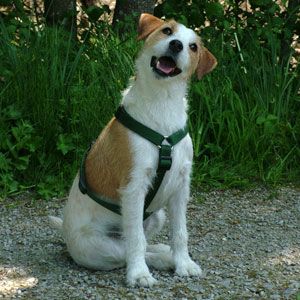
How can I help you?
Keep reading, this page contains plenty of information and is 3500 words long!
The purpose of the website is to try to understand the various aspects of the harness themes:
the difference with a collar, the characteristics of various models, the bases for learning how to fit it without too much trouble, maintenance and washing.
You will find also many tips for buying the most appropriate accessory according to your needs and those of your dog.
You will find below an index of the topics, you can use it to jump directly to the section of your interest.
Alternatively start reading all points.
Ready? Go.
Harness for dogs: what is it?
The harness is a tool that allows the owner to control and guide his dog when he takes it out for a walk.
It may seem a minor element in the shared life between animal and man, but in reality it is not.
Think about it: it is something that you will make your four-legged friend put on and wear whenever you need to take it outside to do its bathroom needs.
An operation that you will have to repeat many times during the day.
The harness is also the final dog-master communication tool during the walk.
Through it the light tensions transmitted by the leash will reach the dog and our friend will interpret them as a stop order in case of danger, or a request to change direction following a distraction.
In recent decades, the harness has been a great success, becoming the choice preferred by many dog owners instead of the classic collar.
It is good to clarify immediately that in reality it is not possible to consider one of these tools better than the other. Both the collar and the harness have their advantages and disadvantages.
This website tends to prefer the use of the harness but still has a critical approach to the instrument.
There is, first of all, a necessary condition that the dog - regardless of any chosen element used to attach the leash - has been properly trained to walk in step with the owner.
Collar or harness: when and why should you choose the second?
Collar
The two most common collars are of the fixed and strangular type.
The fixed collar has the advantage that does not need to be put on and removed every time (provided it is adequately soft and comfortable), you just attach the leash and go. On the other hand it can be easily removed by the animal if it moves backwards and can cause damage to the neck if the dog pulls too much.
Care should also be taken not to adjust it too tight or too loose.
Finally, if it is built in metal or other hard material, it could ruin and tear the animal's fur.
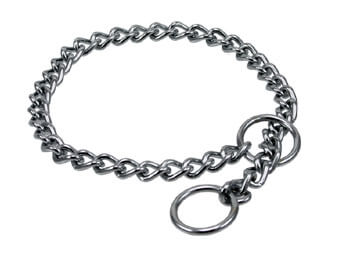
The choke chain is an often demonized type of collar but instead brings some advantages: it is almost impossible for the dog to escape with a pull backwards and it does not damage the hair of the animal.
However, it remains an instrument to be used with extreme attention:
if our friend pulls with force, it could get really noticeable damages.
In the post "Choke Chains: Why they won’t stop your dog pulling on the lead" following problems are mentioned:
- Injury to the blood vessels of the eye
- Damage to the trachea and esophagus
- Severe trauma of the cervical spine
- Fainting
- Temporary paralysis of the front legs
- Paralysis of the laryngeal nerve
- Ataxia of the hind limbs
Generally, the problem is not the collar.
In detail, the choke collar can cause the problems mentioned above, but only if it is used in an incorrect and not very conscientious way.
OK, but we like the harness!
True, this is still a website that prefers the harness. :-)
The beauty of the harness is that you should never have some of the problems listed above, when you use it.
So let's see the main advantages that the owner receives by choosing this tool:
- if well secured, the harness does not come off
- if the dog makes strong pulls on both sides, the harness potentially produces less damage to the animal (to its neck, esophagus, cervical, etc.)
- it is the ideal choice for dogs with respiratory problems
- it is the (almost) an obliged choice for some types of races (we'll see later)
- it is a tool that allows you to direct the leash tensions on points that are less sensitive to trauma
We should clarify one point:
there is no harness that can train the dog not to pull!
Sometimes we read on the forums and on the web of dog owners satisfied from the results obtained by using specific anti-pulling harnesses.
These are incomplete testimonies because they omit to mention what happens after the initial experience.
In fact, in all likelihood, shortly after, as soon as the dog has made it a habit, it will resume pulling, even more than before!
The harness is instead an almost necessary choice for owners of dogs with difficult breathing.
It is absolutely advisable for all the muzzled-faced breeds such as pugs and buldogg.
These types of dog normally suffer of breathing problems and are often out of breath... let imagine how they feel with a collar that tightens the trachea!
In these case, you should conclude…
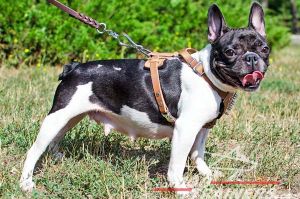
Short nasal duct?
Collar vs Harness = 0 – 1.
Generally, the harness is the right and simpler choice for all the owners with little experience that have medium-small and easy to manage dogs.
Harness models
Let's explore at this point the harness models on the market and see which are the most suitable ones and for what requirements, by analyzing the advantages and disadvantages related to each type of harness.
There are basically three types of harness: H-shaped model (roman), X-shaped model (scapolar), Y-shaped model (swedish or scandinavian).
H-shaped model (roman)
The harness of type H (known also as roman) consists of two circumferences of cloth that surround the dog, one near the neck/bust and the other for the trunk.
The hooking takes place on the lower side, trunk height, after inserting the other part (collar style).

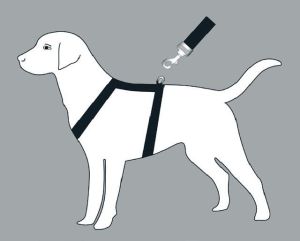
The leash attachment usually takes place on the lower part.
The force is therefore placed on points close to the trunk of the animal, leaving shoulder blades and elbows free to move.
With this type of harness even if the dog pulls like a maddog it will hardly suffer damage to joints or articulations.
Added value: the position of our furry friend will tend to remain natural and correct, paws and shoulders will never be pushed towards the outside causing wrong postures.
The optimal hook on the leash should be placed exactly in the middle of the trunk of our furry friend.
I have seen around many models with a front attack, on the chest, and these should be avoided like the plague!
The H harness is a very comfortable model for the dog that does not feel constrained at all.
This helps our friend to feel comfortable and improve our communication with the dog during walks.
X-shaped Model (scapolar)
The harness of type X (also known as scapolar) is composed of two semi-circumferences of cloth that tighten the dog under the neck and under the shoulder blades, joining on the outside where there is a closing hook and the attachment for the leash.

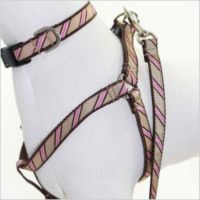
The X type harness discharges the tension towards a very restricted point of the dog's body.
Conceptually it might seem similar to the H-shaped model, but in reality it is not:
the X type harness discharges the tension towards a very restricted point of the animal's body (almost delicate as the neck), i.e. the shoulder blades.
Its use is strongly discouraged because, when the dog pulls vehemently or makes strong pulls, it will be pushed to open the elbows with a negative effect on the posture and with a long term potential damage to the affected joints.
The harness also causes a not indifferent pressure on the armpits of our friend ripping its hair because of rubbing (take notice if you see a dog that usually uses this type of harness) and is going to push the glands present at that point.
Y-shaped Model (swedish)
The model Y (known also as Swedish, Norwegian or Finnish… i.e. Scandinavian! :-)) is made up of two circumferences: a vertical one that surrounds the dog's belly and a horizontal one that tightens the chest.
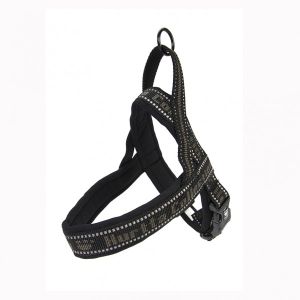
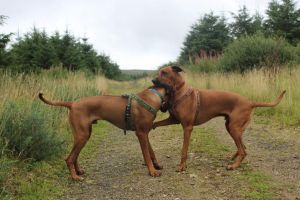
Y-shaped Model offers good control. And it is easy to wear.
It is right on the chest area that the force is felt while we pull our friend on a leash. A part certainly safer and protected from damage caused by sudden blows and very strong pulls.
The Y type mode – similar to the H type model – has been developed in various ways.
The logic approach is however common to all of them: the torso and chest bands join on a single point of attachment and are not connected by an additional band on the back unlike the Roman harness.
The control of the dog remains on a point closer to the neck, where the animal is anthropologically prepared to receive signs of dissuasion and alert.
This harness is very easy to wear, requires only one hooking operation. In fact, the first piece is inserted like a collar and then the two tapes are closed with a clip girdling the dog's torso.
Finally, this is the model that offers the greatest control of the dog because the point of hooking for the leash is more advanced than the H model: a possible pull to stop the dog from an attempt to catch or bite is simpler and more effective.
This is why it is the most suitable model for adult and/or big size dogs...
For puppies or small dogs, the H-shaped model is to be preferred.
What is the best harness model?
This is the final question.
It seems obvious, on the basis of what we have discusssed before, that the choice of the harness should mainly be between the H or Y model.
The scapular, X model, is certainly a model to discard and to stay away from.
In essence I prefer the Swedish model Y, when I want to offer comfort and a sense of freedom, in addition to a good communication and control by the owner.
I suggest the H model, in the case of inexperienced owners of dogs which are still learning to go to step.
At this point we summarise the merits and defects of the various types of harness in order to help you to make your choice:
Best security
Even if the dog pulls like a maddog it will hardly suffer damage and its posture will remain natural
Good control
The hook on the back of the trunk helps to manage well the dog but with some loss of control. If you look for the best model , the Y-shaped model is better.
Good security
Not at the level of the Roman harness, but the security is anyway guaranteed for dogs and owners with a minimum of experience
Greater control
The management of the dog is easier in the case of sudden "surges" thanks to the advanced hook
Bad security
The force is concentrated on the shoulders and underarms and is going to press on the lymph nodes of the point causing problems to joints and posture in the long run
The control itself is not bad ... but the potential damage is not worth the game.
TO BE AVOIDED!
Other types of harness
There are many variations of the object that over the years has evolved a lot from the basic models H and Y.
Some call them "chainsaw models", it is basically a Swedish Y-shaped harness, but with a link on the bust reinforced by a very strong terry cloth support.
They are excellent products with great resistance.
The Julius-K9 is the model that has been the pioneer of this new concept.
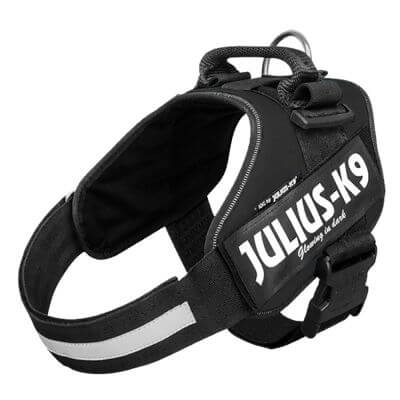
Julius K9's models are basically a Swedish Y-shaped harness.
It is also equipped with a handle, that allows to keep the dog steady when it is necessary to control it at a very short distance.
Overall, they are excellent quality harnesses.
Too bad that their heaviness can in some way affect the relaxation of the dog making it feel more constrained and bandaged than is actually necessary.
For this reason I personally prefer more essential models.
How to use the harness: how put it on and wear it quickly
Let’s move on to the step of actually using the tool.
The operation that consists of putting on and wearing the harness on your dog is in itself quite simple.
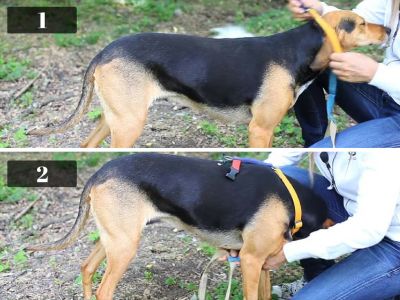
Two steps to wear the H-shaped model.
Depending on the model, just insert the neck/bust into the appropriate spaces and then proceed to fix the bands with the dedicated clip closure.
For example, in the case of the H-shaped model, as we have already said, the harness must be passed first by the neck (1) and then closed on the dog's torso (2).
Training the dog to put on the harness
In reality, the hard work to be done to put the harness on the dog is certainly not the joining of two clips and closures between them, but rather to train the unruly friend to the operation and to the gestures.
Have you ever tried to put a harness on a dog that has never seen it before?
In 99% of cases it is a nerve-wracking job.
In fact, our friend will not accept being stuffed and squeezed inside that piece of cloth and plastic.
It will tend to rebel, run away and nibble on the leash.
The simple gesture of inserting its head and neck into the entry slot of the harness is not a good thing according to the dog perspective, independently of the race.
Instinctively it will at least tend to lower the head and dodge the hole.
It is as well likely that it is going to emit some growl of dissatisfaction abot the closure to the bust.
All these reactions will be stimulated by the emotional mix that is triggered when the dog realizes that is about to begin the long awaited walking time.
Therefore, it is clear that you need to train the dog to the execution of the gesture to make sure that wearing the harness before going out does not become a drama (especially for the owner :)).
There are many exercises that allow the animal to get used to the item.
I recommend you to watch this video that shows how - through a reward - our dog will more willingly introduce its head into the hole by associating the gesture to a pleasant moment (never heard of positive reinforcement? :)) :
[Watch the video How to accustom the dog to the harness]
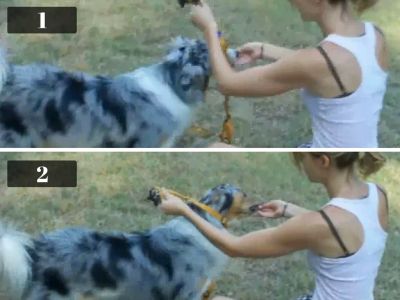
Training the dog to put on the harness with the help of a tidbit
How to do it:
- prepare the harness keeping it from the attachment point (so that the latter is then placed on the back of the animal) and putting in front of the dog the hole where it should introduce its head;
- with the help of a tidbit, Fido is invited to get inside;
- automatically reward it every time the dog does it;
- then finish by hooking the closure on the bust.
Maybe at the beginning it will not be that easy and you may have some difficulty applying the technique.
You must not give up, I assure you that if you are consistent, with a little bit of exercise - and by giving many rewards to every well executed work our friend is going willingly to put the head in the hole of the harness.
Chosing the correct size and adjustment
The choice of the right size is a very important factor for the correct functionality and safety of our accessory.
You should know that the dog does not have to wear the harness too tightly.
At the same time, having it too wide is uncomfortable and dangerous (it could slip out after the first backward pull).
The choice of the harness size should be made by measuring the size of the dog.
In the case of the Roman harness, if you want to be scrupulous - and to avoid purchasing the wrong size - you can use a tape measure to determine the circumference of the neck and the half of the trunk.
For the Swedish model you should move slightly further down the chest from the neck.
Some large manufacturing companies simplify the choice of their products by reporting their compatibility with the breed of the dog.
Hurtta – for example – have on their website a specific page for the calculation of the measures.
On the labels they usually report the size of the animal compatible with the accessory according to its weight.
Notice however: you do not need to be precise to the millimeter anyway.
Once you have chosen the right size you can perfectly adjust the accessory on the body of your friend by using the appropriate straps.
Consider that the ideal choice would be to leave between the body of the animal and the harness about one to two fingers of space, to avoid making our friend feel too tight in order to avoid annoying rubbing.
Remember: neither too tight nor too wide.
Consider, for example, that an overly generous adjustment of the Y-shaped harness causes when you pull a behavior very similar to the scapular models!
Finally, make sure to always perform the final test to see if the harness slips off pulling it in various directions.
It is really unpleasant, as well as very dangerous, to suddenly find yourself with Fido free on the street and out of our control.
Simples / Cheap Harnesses
Simple pieces of cloth and nylon... but still well made!
I love simplicity. Sometimes being minimal in your choices is the best thing.
I think so also about the harnesses.
I do not consider too heavy, padded and complex models suitable for my medium-sized mixed-breed dog.
Personally I recommend the H-shaped Trixie that I have been using for many years.

More than good quality, nylon fabric, minimum weight and clutter so that my little girl does not feel oppressed.
Choosing the appropriate leash
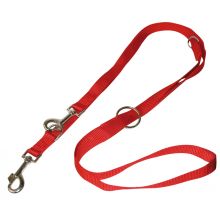
A couple of hints on the fly on how to choose the most suitable leash to be applied to the harness.
First of all, let's immediately say no to the flexi type, the extendable and extendible leashes. Why?
By its nature this type of leash is not good since it will tend to always remain tense and never soft, which is not at all positive because it will not allow the dog to appreciate the signals of the owner during the walk.
Also it is very difficult to recover Fido when he begins to pull (because perhaps intrigued by a pigeon or a cat).
In addition, it is a virtually useless accessory for large dogs that could destroy it "with a single blow".
The ideal leash is among those with rings that allow some adjustment.
Important to keep it short in crowded places: the length when walking in public places must not exceed - according to the law of many countries (i.e. see the law in New York City) - 1.5/2 meters.
It will then be possible to change the setting and increase the length when the situation allows it.
Maintenance and cleaning of the harness
Let's close with some small advice on the maintenance that occasionally need to be given to our accessory.
Really nothing transcendental.
The harnesses and leashes in fabric can in fact be washed by hand or in the washing machine.
The important thing is that the washing is performed by treating everything as if it were a delicate garment.
Water temperature not too high (40-50 ° C) and the liquid detergent you use for your clothes are just fine.
Then let them dry by spreading the unusual items to dry (preferably protected from direct sunlight).
Obviously if you wash in the washing machine, avoid centrifuging!
Finally it is always good to verify - one-off - the general conditions of the tool.
Check the integrity of the fabrics and the absence of tears or injuries that our friend may have caused by nibbling.
Also check that the clips and couplings are all intact.
They are usually made with plastics which tend to "dry out" and break easily if they are very old or left in the sun for quite some time.
Check also the metal rings and verify that they are not oxidized
All this to avoid that the harness can suddenly break during a walk, after a pull of the dog, leaving the dog suddenly free.